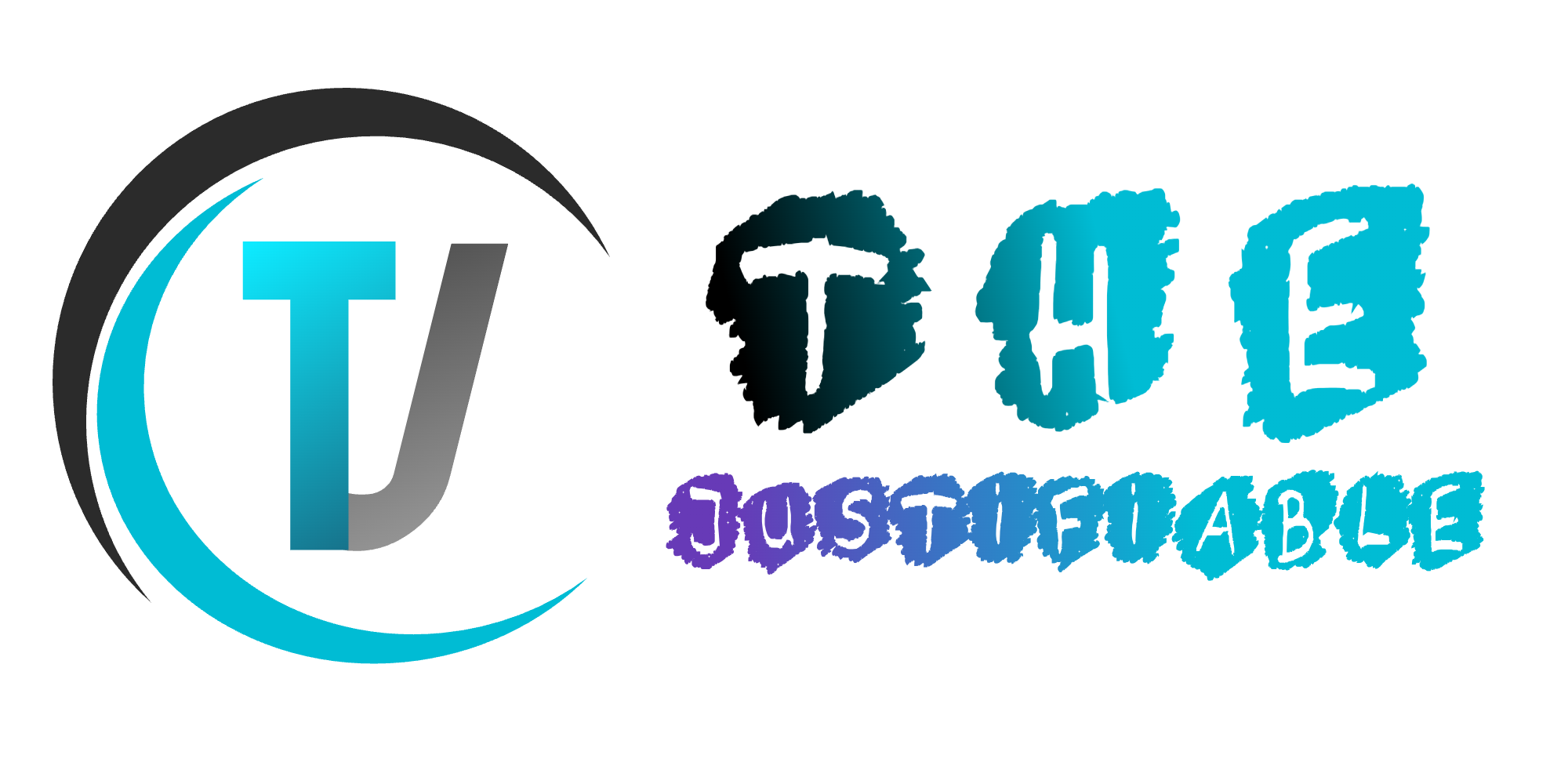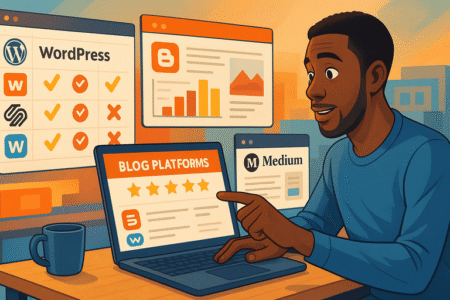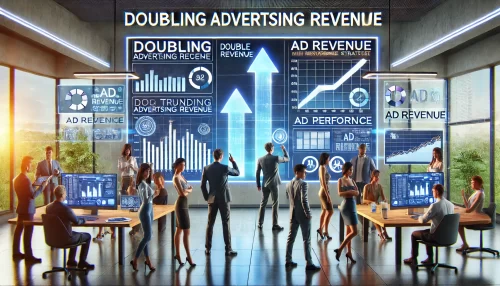Table of Contents
Are you searching for free blog sites to make money but not sure which ones actually work?
Maybe you’ve wondered if starting on WordPress, Blogger, or Medium can really put cash in your pocket. Or perhaps you’re asking yourself: which platforms are best for beginners, and which ones give the fastest path to monetization?
In this guide, you’ll find the answers and discover the top free blog sites that can help you turn your ideas into real income without spending a dime.
Why Free Blog Sites Are Perfect For Making Money
Starting with free blog sites to make money might sound too good to be true, but the reality is these platforms give anyone a no-risk entry point into online income.
They remove the usual barriers like upfront hosting fees or coding knowledge, making blogging accessible to anyone with a laptop and a Wi-Fi connection.
Avoid Startup Costs With Zero Hosting Fees
Most people hesitate to start a blog because of the costs. Hosting, domain registration, themes — it all adds up before you even publish your first post. Free blog sites wipe out that worry.
Platforms like WordPress.com or Blogger handle the hosting for you, meaning you can go from idea to live website in minutes without pulling out your credit card.
I’ve seen beginners overthink the money side of blogging, believing they need expensive themes and plugins.
The truth? You can test your ideas for free and upgrade later only if you’re serious about scaling. This mindset keeps your risk low and your learning curve high.
Build An Audience Without Technical Skills
One of the biggest perks is that you don’t need to be a developer. Free platforms have drag-and-drop editors, pre-designed templates, and easy publishing tools. For example, on WordPress.com, you simply log in, click “Write,” and your article can be published instantly.
The faster you can produce and share content, the faster you can attract readers. Instead of debugging code, you’re writing stories, tutorials, or product reviews — the real fuel that builds an audience.
Monetize Faster With Built-In Features
Free blog platforms often include basic monetization options right out of the box. Blogger integrates directly with Google AdSense. WordPress.com offers WordAds on its higher tiers. Medium pays writers based on reader engagement.
This means you can experiment with income streams — ads, affiliate links, or even digital products — without waiting months to learn web development or spend hundreds on custom setups. The focus shifts from tech headaches to making content that earns.
WordPress.com: The Most Popular Free Blog Platform
WordPress.com stands out as the go-to free blogging site for beginners and pros alike. It’s built on the same foundation as the self-hosted WordPress.org but requires no installation or hosting setup.
That makes it a simple way to start writing and monetizing without worrying about technical details.
How To Set Up A Free Blog On WordPress.com
The setup process takes minutes. Here’s a quick path:
- Go to WordPress.com and sign up with your email or Google account.
- Pick a blog name and choose the free plan.
- From the dashboard, click “Site” > “Design” to select a theme.
- Click “Write” at the top menu to start publishing.
No plugins or hosting configuration needed. Everything is managed for you, so the barrier to entry is almost zero.
Best Monetization Options Available On WordPress.com
On the free plan, you can insert affiliate links, promote your services, or direct readers to paid products. If you upgrade later, you unlock WordAds, which is WordPress’s own ad program.
I suggest beginners start with affiliate links since they’re allowed even on the free plan. For example, you could write a review on a book you enjoyed and drop in an Amazon Associates link. It’s a natural way to earn commissions without heavy traffic.
Limitations To Watch Out For Before You Start
The trade-off with WordPress.com is flexibility. On the free plan:
- You don’t get your own custom domain (you’ll have something like yourname.wordpress.com).
- Plugins are restricted, so advanced SEO tools aren’t available.
- Monetization is limited compared to the self-hosted WordPress.org.
Still, it’s a perfect testing ground. I believe if you’re just exploring blogging, WordPress.com lets you validate your ideas without financial risk.
Once you see traction, you can decide if upgrading or moving to WordPress.org makes sense.
Blogger: A Google-Owned Option For Earning Online
Blogger is one of the oldest free blogging platforms still around, and while it’s not as shiny as Wix or WordPress.com, its integration with Google’s ecosystem makes it incredibly practical for earning online.
Easy Integration With Google AdSense For Passive Income
The killer feature of Blogger is its built-in AdSense integration. From your Blogger dashboard, you can go to “Earnings” and link your Google AdSense account in just a few clicks.
This makes monetization straightforward since ads will display automatically without you needing to code or install widgets.
If you’re patient and keep producing content, AdSense can provide steady passive income once traffic builds. The best part is that because Google owns both Blogger and AdSense, the approval process is smoother than on other platforms.
Customization Features That Boost Visibility
Even though Blogger isn’t as flashy as other builders, it still offers customization:
- Choose from free templates under “Theme.”
- Edit layouts under “Layout” for sidebar widgets, ads, or affiliate banners.
- Add SEO-friendly titles and descriptions for each post under “Settings.”
These features aren’t cutting edge, but they’re enough to make your blog stand out and attract search traffic.
From my experience, adding a custom logo and simple layout tweaks instantly makes a Blogger site feel more professional.
Drawbacks Of Blogger Compared To Other Platforms
Blogger’s biggest weakness is its dated feel. The templates can look generic if you don’t customize them, and the platform hasn’t seen major updates in years.
Another limitation is portability. If you want to move later to another platform, migrating your site isn’t as smooth as with WordPress. Also, while AdSense integration is easy, you won’t find advanced monetization options like affiliate widgets or built-in ecommerce tools.
Still, if your main goal is to get content out fast and start displaying ads, Blogger remains a solid choice. It’s especially useful for beginners who want to learn the ropes of content creation without overcomplicating things.
Medium: Get Paid To Write Without Building A Website
Medium is unique because you don’t even need to worry about creating or maintaining a website. You write, publish, and get paid if people engage with your stories.
For anyone who feels overwhelmed by the tech side of blogging, Medium clears the clutter and puts the focus squarely on your words.
How The Medium Partner Program Pays Writers
Medium pays through its Partner Program. Here’s the gist:
- Readers pay a subscription to Medium (currently around $5/month).
- When they read your articles, you earn based on how much time they spend engaged with your content.
- You also earn when someone joins Medium using your referral link.
To join, go to your Medium dashboard, click your profile picture, then “Medium Partner Program.” Once approved, you can start publishing and earning.
What I like here is that you don’t need ads, affiliate links, or a personal site. You just focus on storytelling.
The payout can vary, but I’ve seen writers make anywhere from a few dollars to thousands a month, depending on how often they publish and how compelling their work is.
Tips To Get More Views And Engagement On Medium
Getting traction on Medium isn’t just about writing good articles — it’s about strategy.
- Leverage publications: Submit your posts to established Medium publications like Better Humans or Towards Data Science. These already have large audiences.
- Optimize headlines: Medium’s algorithm favors clear, intriguing titles. Instead of “How to Save Money,” try “I Cut My Expenses by 40% Without Skipping Coffee.”
- Engage with readers: Clap for others’ work, leave thoughtful comments, and connect with fellow writers. It increases your visibility.
In my experience, the fastest growth comes from consistently publishing two to three high-quality stories per week.
Why Medium Works Well For Niche Writers
Medium shines if you’re writing for a focused audience. For example:
- A productivity coach can share tips that resonate with professionals already subscribed to productivity-focused publications.
- A hobbyist in sustainable living can build a loyal following because the Medium community already values thoughtful, niche content.
Unlike starting a blog from scratch where you’re shouting into the void, Medium drops you into an audience that’s ready to read.
That’s why I often recommend it for writers who want proof of concept before investing in a standalone site.
Wix: A Free Blog Builder With Monetization Options
Wix is popular because it blends simplicity with design freedom. You don’t need to know code, and yet your blog can look polished right from day one.
Simple Drag-And-Drop Design For Quick Launch
The Wix dashboard is designed for speed. To create a blog:
- Sign up on Wix.com.
- From the dashboard, click “+ Create New Site.”
- Choose “Blog” as your category.
- Use the drag-and-drop editor to add text blocks, images, or forms.
No tech headaches — you literally drag elements into place like Lego blocks. I recommend beginners start with Wix’s pre-built blog templates because they’re optimized for readability and mobile use.
Using Wix Ads And Affiliate Marketing For Income
On the free plan, Wix runs their own ads on your site, which you don’t control. That’s not ideal, but you can still monetize in other ways:
- Affiliate marketing: Add affiliate links inside your blog posts. For instance, if you write a review of a kitchen gadget, link to it on Amazon Associates.
- Promote services: Use Wix’s “Bookings” feature to sell coaching, consultations, or digital services.
- Email marketing: Wix has built-in email tools, so you can capture subscribers and promote paid content later.
In my experience, Wix works best for creators who want visual storytelling — food bloggers, photographers, designers — since the platform is highly visual.
Downsides Of Wix Free Plan You Should Know
The biggest drawbacks:
- You’ll have a Wix-branded domain like yoursite.wixsite.com/yourblog.
- Wix ads appear on your site and can’t be removed unless you upgrade.
- Storage and bandwidth are limited.
For testing the waters, it’s fine. But if you want long-term scalability and professional branding, I suggest starting free and moving to a paid plan or another platform once you gain traction.
Weebly: A Beginner-Friendly Blog Site To Earn Money
Weebly is another free option that’s especially friendly for beginners.
It has a simple interface and, interestingly, is owned by Square, which makes it strong for anyone who eventually wants to sell products alongside blogging.
Quick Setup For Blogging And Online Selling
Weebly keeps things straightforward:
- Sign up at Weebly.com.
- Choose a theme (the platform offers clean, mobile-friendly designs).
- Use the drag-and-drop editor to start adding text, images, or videos.
From the dashboard, click “Pages” > “+ Add Page” > “Blog Page” to instantly create a blog section. You can start publishing posts immediately without extra setup.
I like that Weebly also integrates with Square’s ecommerce tools. If you think you might sell physical or digital products later, it’s built in from the start.
Monetization Opportunities Through Ads And Products
Weebly lets you monetize in a few ways:
- Display ads: You can insert Google AdSense code in your blog settings.
- Affiliate marketing: Embed affiliate links naturally in your posts.
- Ecommerce: Sell products directly on your site thanks to its Square integration.
This makes it unique compared to Wix or Blogger because you can actually merge content and store functionality under one roof.
Where Weebly Falls Short For Professional Bloggers
The downside is customization. Weebly isn’t as flexible as WordPress or Wix. Its template selection is more limited, and advanced SEO tools aren’t as strong.
Another issue: the free plan also comes with a branded domain (yoursite.weebly.com), which looks less professional for long-term growth.
Still, I think Weebly is underrated for beginners who want a gentle introduction to blogging with the option to sell things down the road. It’s a solid middle ground between a pure blog platform and a full ecommerce store.
Tumblr: Turn Creative Blogging Into Real Income
Tumblr is often overlooked, but it’s a hidden gem for creative bloggers who thrive on visuals, memes, and micro-content.
It works more like a social network than a traditional blog, which means building an audience is often faster.
Using Tumblr’s Community For Affiliate Marketing
Tumblr has a loyal, niche-driven community. You’ll find subcultures around fashion, art, gaming, and fandoms. This makes affiliate marketing powerful here if you pick products that fit those niches.
For example, if you’re into anime, you can write short reviews of merch, drop affiliate links from Amazon, and attach them to your posts.
Tumblr’s format allows you to mix GIFs, images, and short text that feels native to the platform — and that kind of casual, shareable style tends to spread quickly.
Practical tip: Always disclose affiliate links, and keep the content genuine. On Tumblr, users value authenticity over hard-selling.
How To Leverage Sponsored Posts And Brand Deals
Once you’ve built an active following, brands notice. Sponsored posts on Tumblr usually come in the form of rebloggable content: images, short videos, or even memes with a brand tie-in.
For example, a fashion blogger might collaborate with a clothing line to create aesthetic photosets. Brands love Tumblr for the organic, grassroots feel, so your content shouldn’t scream “ad.” Keep it natural and creative, and you’ll land more collaborations.
Why Tumblr Works Best For Visual And Lifestyle Bloggers
Tumblr thrives on aesthetics. If your content involves visuals — fashion lookbooks, travel photography, fan art, or lifestyle tips — Tumblr’s dashboard feed makes it highly shareable.
It’s not ideal for long-form blogging or SEO-heavy content, but if your strength lies in visual creativity and quick posts, it’s one of the fastest ways to turn engagement into real income.
LinkedIn Articles: Earn From Professional Blogging
LinkedIn isn’t just for job hunting — it’s one of the best free blog sites to make money if your focus is professional services, consulting, or B2B industries.
Writing articles here positions you as an expert and can directly bring in leads.
How Writing On LinkedIn Can Generate Leads And Clients
Every article you post on LinkedIn shows up in your network’s feed, and often beyond if people engage. That visibility builds authority fast.
I’ve personally seen consultants land clients simply by publishing regular thought leadership pieces.
For example, if you’re a career coach, an article titled “How I Helped 3 Professionals Land Remote Jobs in 90 Days” naturally showcases your skills while subtly inviting readers to hire you.
Tips To Turn Articles Into Consulting Or Coaching Offers
Here’s a simple flow I recommend:
- Write a detailed, helpful article around a specific problem (e.g., “5 Resume Mistakes That Cost You Interviews”).
- At the end of the article, add a soft call-to-action like: “If you want personalized help fixing your resume, let’s chat.”
- Link to your calendar booking tool or a services page.
Because readers already trust you after consuming your content, conversions tend to be much higher compared to cold outreach.
Why LinkedIn Blogging Is Ideal For Professionals
Unlike other platforms, LinkedIn brings together people who expect business-related content. That means your audience is already primed for services, consulting, or digital products.
If your goal is direct client work, LinkedIn is far more efficient than chasing ads or affiliate sales. I believe it’s the fastest bridge between content creation and actual revenue for professionals.
Tips To Choose The Best Free Blog Site To Make Money
With so many free platforms out there, the “best” choice depends on your goals. A lifestyle blogger will need different tools than a career coach, so it’s important to match the platform to your vision.
Match Your Blogging Goals With The Right Platform
Think about what you want:
- If you want to write long-form articles, Medium or WordPress.com is a solid choice.
- If you want to sell services or consulting, LinkedIn will likely bring faster results.
- If you’re visually creative, Tumblr or Wix may fit better.
- If you want ads and passive income, Blogger is straightforward.
Start with your income model in mind, then choose the platform that supports it best.
Evaluate Monetization Policies Before You Commit
Not all free blog sites have the same rules. For example, WordPress.com restricts certain monetization methods on the free plan, while Blogger gives you direct AdSense integration.
I advise reading the fine print on each platform’s monetization options. Nothing is worse than building momentum and then realizing you can’t monetize in the way you intended.
Consider Long-Term Scalability And Future Upgrades
Free sites are excellent for testing, but if you want to scale, you’ll eventually need more control. I always suggest asking yourself:
- Can I upgrade to a paid plan later without losing content?
- Is it easy to migrate my blog if I outgrow the platform?
For instance, WordPress.com can be upgraded seamlessly, while Blogger migrations can be clunky. Thinking ahead saves headaches later.
Pro Tips To Maximize Earnings From Free Blog Sites
Getting started is easy, but growing actual income requires smart strategies. These tips will help you get more from your efforts on any platform.
Use SEO To Attract Consistent Organic Traffic
Even if you’re on a free blog site, you can optimize posts with simple SEO steps:
- Write headlines with clear keywords (e.g., “Best Budget Travel Tips for 2025”).
- Add alt text to images for search visibility.
- Structure posts with headings (H2, H3) so Google understands your content.
Traffic from search engines compounds over time, making it easier to monetize consistently.
Combine Multiple Income Streams For Higher Profits
Don’t rely on just one source. The most successful bloggers mix:
- Ads (AdSense, WordAds).
- Affiliate marketing.
- Services or coaching.
- Digital products like eBooks or templates.
Even on free platforms, this approach diversifies your income. For example, you might write an article with affiliate links while also offering a free download in exchange for joining your email list.
Build An Email List To Retain And Monetize Readers
Platforms come and go, but your email list is yours forever. Even if a free blog site shuts down, you can still reach your readers.
Here’s how I’d start:
- Use a free email tool like Aweber or MailerLite.
- Add a sign-up form to your blog (Wix, Weebly, and WordPress all allow this).
- Offer a small incentive, like a free guide or checklist.
Once you have subscribers, you can promote your blog posts, affiliate offers, or paid services directly. That’s where the real long-term money is.






